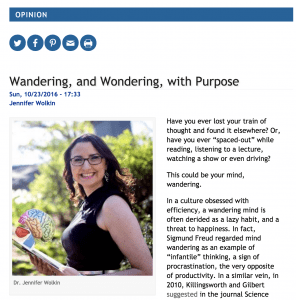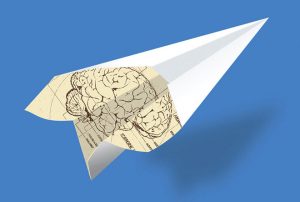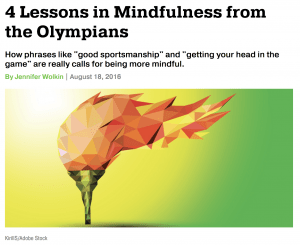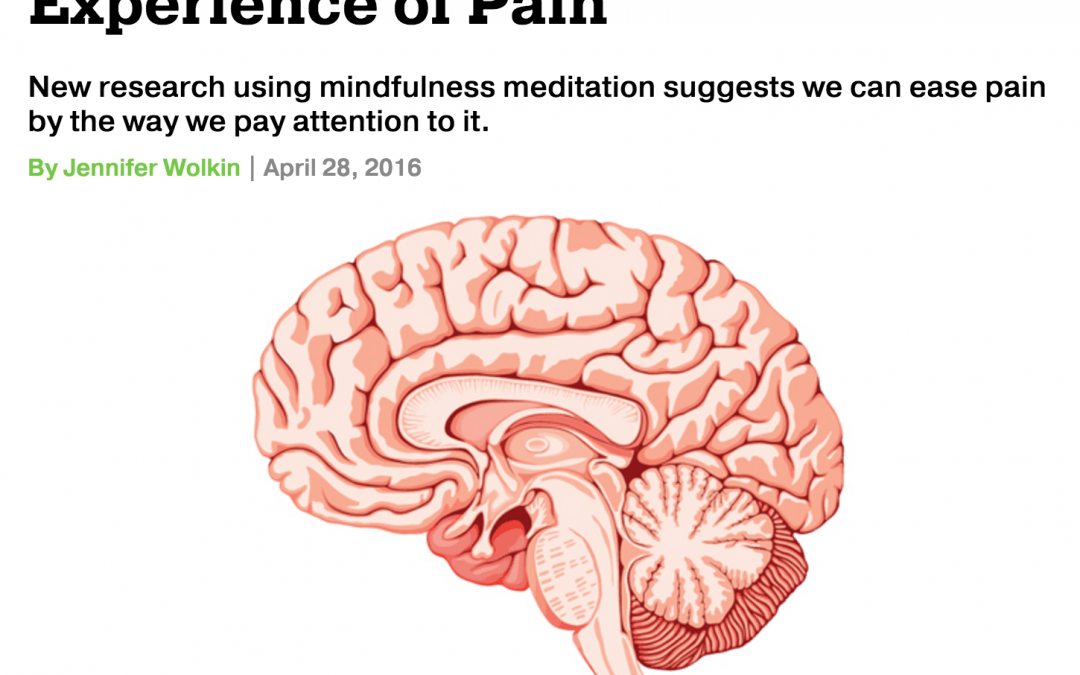
by Jennifer Wolkin | Oct 23, 2016 | Blog, Mindfulness, Wellness
This post originally appeared in The Jewish Week

Have you ever lost your train of thought and found it elsewhere? How about “spaced-out” while reading, listening to a lecture, watching a show or even driving?
This could be your mind, wandering.
Mind Wandering refers to the phenomenon of being unable to focus on any single topic for a long period of time. As it turns out, it is very common. There is even evidence that indicates that mind wandering may constitute a psychological baseline; research shows that our brains’ daydream so easily and effortlessly that it appears to be our default mode of thought (http://www.ncbi.nlm.nih.gov/pubmed/17188554).
 In a culture obsessed with efficiency, a wandering mind is often derided as a lazy habit, and a threat to happiness. In fact, Freud regarded mind wandering as an example of “infantile” thinking, a sign of procrastination, the very opposite of productivity. In a similar vein, in 2010, Killingsworth and Gilbert wrote in Sciencemag.org that: “A human mind is a wandering mind, and a wandering mind is an unhappy mind (http://greatergood.berkeley.edu/images/application_uploads/KILLINGSWORTH-WanderingMind.pdf) .”
In a culture obsessed with efficiency, a wandering mind is often derided as a lazy habit, and a threat to happiness. In fact, Freud regarded mind wandering as an example of “infantile” thinking, a sign of procrastination, the very opposite of productivity. In a similar vein, in 2010, Killingsworth and Gilbert wrote in Sciencemag.org that: “A human mind is a wandering mind, and a wandering mind is an unhappy mind (http://greatergood.berkeley.edu/images/application_uploads/KILLINGSWORTH-WanderingMind.pdf) .”
Yet, on the flip side, a study from the University of British Columbia found that while mind wandering is usually associated with “laziness or inattentiveness,” the human brain is actually very active while daydreaming. (http://www.sciencedaily.com/releases/2009/05/090511180702.htm).
In that study, psychologists used brain scans to study participants as they performed easy, mindless assignments and found that their brains did indeed wander – but it was also during that period that the section of the brain known as the “executive network” was the most active.
This executive network, incidentally, is what we turn to when confronted with a high-level, complex problem. So daydreaming, according to this study, could help us solve some of our most pressing problems.
This suggests that mind wandering isn’t quite as mindless as it was previously considered. A daydream seems to produce parallel processing in two supposedly oppositional neural networks: the active executive part and the resting default.
How do we resolve this apparent contradiction? Let’s consider that the explanation resides in the fact that it’s not enough to simply daydream. Letting the mind drift off is the easy part. What’s much more difficult (and more important) is maintaining a touch of meta-awareness, so that if you happen to come up with a useful new idea while in the shower or sitting in traffic, you’re able to take note of it. In other words, “zoning out” might not be such a bad thing, as long as there is a conscious ability to hone and nurture what happens during that time.
To take this even further, research suggests that if we are somewhat mindful of where our minds are, without judgment, of course, the act of mind wandering might be essential to conjuring deep thoughts essential to living a connected and balanced life.
So, in an ironic riff on the idea that mindfulness is rooted in being “here and now”, when we are mindful of our mind wandering, it becomes functional.
I can’t help but realize how apropos this idea is during the time of the Jewish festival of Sukkot (“Huts”). This holiday is literally the quintessential WANDERING holiday! It commemorates the time that the Israelites spent wandering (yep, wandering) in the desert. The only shelter that they had at that time was from the temporary huts, or dwellings, that they erected during their 40-year journey.
What makes the journey distinctive is that while traveling in the desert, the Israelites were not wandering aimlessly from place to place, though it might have appeared that way. They were consciously connected to something greater than themselves. In the desert, for the first time in their history, they truly grew into one nation connected to their ancestry and progeny, to their culture and religion, and to a “higher power.”
In today’s day and age, The flimsy sukkah structure returns those who observe the holiday to this time in Jewish history, while also catapulting us into our future as we make new memories for the next generation.
In addition to this generational interconnectedness, dwelling in this transient “home” also connects us to the tenuous nature of life. Just as our thoughts come and go, so does life. The temporary sukkah reflects our impermanence. Yet, sitting in the sukkah symbolizes at once the fragility of life, and also all that is at our fingertips to celebrate, if we choose to be mindful of it. This is the real beauty of the sukkah; that in the midst of the transience, there is the opportunity to experience joy and hope.
In honoring the nomadic, wandering lifestyle and in building our literal and metaphorical “sukkah,” we are allowing ourselves to continue to connect ourselves with our past, present, and fruitful future.
So go ahead, I dare you…wander.
Let’s wander toward thriving, together,

Dr. Jen/Jennifer Wolkin, PhD

by Jennifer Wolkin | Oct 2, 2016 | Blog, Mindfulness, Wellness
This blog post originally appeared on YogaCity.

Trying to write my dissertation jolted me into a realm of self-blame and self-criticism. I procrastinated because it was a burden, a dragon whose fiery mouth I wanted to avoid at all cost. I was anxious and I struggled with that internal voice of doubt that whispered, “are you sure you are good enough for this?”
Early on, immersing myself didn’t feel good. I definitely did not expect it to be easy. Nothing worth doing gets done without hard work ever is – but I certainly couldn’t have predicted the negative energy that I allowed the dissertation to create.
So I avoided it in an attempt to make all the negativity disappear. Of course, the more I avoided it, the bigger it became.
Then I began to devote myself to a modest practice of yoga to find more tranquility, focus, and calm. At first it was nearly impossible. My mind raced with thoughts: thoughts of fear, uncertainty, worthlessness, inability to succeed, and even thoughts about thoughts.
My initial poses were haphazard, pretzel-like and ungraceful. My breath pattern was quick and shallow, reflecting my difficulty holding the asanas as my mind strayed in all directions. “At least,” I kept telling myself, “I was coming to the mat.”
As long as I carved out my space, a little rectangular niche of my neon green rubber yoga mat, I was going to be okay. By the time savasana approached I could at least surrender my self-deprecating thoughts to some indescribable energy created by the convergent effects of movement and breath.
Yoga gave me perspective, which I craved, and I began to practice up to four days a week. Soon, the natural progression of my day became a yoga practice and then hours of writing. The energy generated through yoga was evident in the organization of my thought and ability for my thought to be transferred coherently into words. To do yoga and then write was a logical pattern I fell into.
Ultimately, I chose to bring my journey both off the mat, and out from behind my computer. I let go of the striving to finish it, and the attitude of just “needing to get this done and over with.” Slowly but steadily learned to reinforce the small steps, as I remembered my practice and the way my once quick and shallow breath slowed down and became more melodic, deep, and visceral, to the little baby steps I made with my balance until my physical core and my spiritual core became stronger.
In this way, the yoga was an organic foray into learning about mindfulness and how to engage any process through a more mindful lens. As I cultivated my ability to focus on the breath as I moved in and out of asana, my mind wandered less; instead, I became present to the moment as it was unfolding. Being present, it turned out, was more enjoyable and fulfilling than remaining on autopilot, and, at the whim of my wandering mind. With the same practice off the mat, the dissertation no longer became something I just did, but became a journey, which I appreciated and sometimes even savored, at every stage.
Yoga practice fostered a lens by which I could see my dissertation as a metaphor for living life in general. That is, as Jon Kabat-Zinn says, “on purpose.”
In the end, neither yoga nor mindfulness will eliminate life’s pressures. Yet, take it from me: embracing life as a journey of poignant moments to be lived fully over the course of a lifetime makes me feel like I’m thriving.

by Jennifer Wolkin | Aug 18, 2016 | Blog, Brain Health, Mindfulness, Relationships, Stress, Wellness
This post originally appeared on Mindful.org

When you watch the Olympics, you can’t help but imagine the countless hours of training all of the athletes have devoted themselves to in order to accomplish the unfathomable feats of stamina, incomprehensible shows of endurance, and extraordinary acts of skill.
And that kind of rigorous training, steeped in competition, often can’t be fully actualized without training the mind as well.
Some of the athletes have been vocal about their penchant for mindfulness meditation as an integral part of their quest for gold. For example, Tom Daley, a diver from Great Britain, told the Telegraph: “You can only do so much in the gym or in the pool.” He continued, “Every morning I do 10 minutes of mindfulness where I do meditation and I use that in competition and every day life… It’s helped me massively and I feel like that’s one of the reasons why this year I’ve been the most consistent that I’ve been in competition.”
Other athletes might be practicing mindfulness without knowing that’s what they’re doing—they just experience the flow state that comes with focused attention.
But what’s clear is that the very mindful way these athletes approach their craft can be seen in their actions. Here are 4 lessons in mindfulness we can learn from the Olympians:
-
Focused Attention is a Skill
A main component of mindfulness is that it helps cultivate awareness by paying attention, on purpose, and in the present moment.
If left to its own devices, our human mind habitually wanders away from the present moment. When we’re not in the here and now, we dwell in the past, grasping and replaying it, or we project into the future, trying to anticipate the unknown (and often catastrophizing).These habitual thought patterns don’t serve our ultimate well-being. This kind of thinking is unhelpful for an athlete who can’t stop thinking about their last failed performance, or one who can’t stop obsessing over what this performance will mean going forward.Have you ever heard a sports announcer say that an athlete must have “been in his head” too much – which caused them to make a simple mistake, but one that cost them the game or race? When we are too focused on what we need to do to win, we lose ourselves in that thought and forget to remain in the moment.
This year, Wilhem Belocian of France, bolted a split second before competitors. The false-start alarm rang out, and the 21-year-old’s hopes of winning a medal in Brazil were over. It was heartbreaking to watch as he collapsed to the ground and punched the pavement before laying on his back with his hands over his face, clearly in agony.
Present moment awareness, honed, is true gift. Equally important is allowing ourselves to grieve, and then forgive ourselves, and move on
-
Compassion is Essential
Mindfulness is more than sitting on a cushion, eyes closed, back aligned, thumbs grazing forefingers, hands resting on thighs. No doubt, this is a feasible and efficient way to cultivate mindfulness, but it’s not the only way.The essence of mindfulness practice is learning to live with more integrity, by nurturing the power to choose our response in any given situation. We begin to live mindfully when we start to cultivate a way of being that embodies mindfulness-based principles like gratitude, loving-kindness, and compassion.
When we are too focused on what we need to do to win, we lose ourselves in that thought and forget to remain in the moment.
For an Olympic athlete, this kind of mindfulness practice is perhaps most reflected in the ability to engage in “good sportsmanship.”A prime example of this is reflected in the actions of Abbey D’Agostino, a Team USA 5,000-meter runner, and Nikki Hamblin of New Zealand. They both collided during a run, fell, and subsequently chose to spend the rest of the race encouraging one another, despite the fact that this had the potential to snuff out either’s chance to qualify for the next run. If someone who has trained and competed for years for this spot can forgive and help out their competition, surely we can see the bigger picture in our own lives as well.
-
Stress is Manageable
Stress-reduction has been noted as a useful byproduct of the practice of mindfulness.
But an appropriate amount of stress is actually adaptive. For athletes especially, the stress-response (also knows as “fight or flight”) elicits an acute surge of adrenaline, and stimulates an increase of blood pumping to the limbs, which helps them as they race towards the finish line. While this mental pressure to beat out the competition is often crucial to success, sometimes the physiological stress response never turns off, and for many of us, stress begins to take the form of negative and unhelpful thinking styles that are often paralyzing.That’s where mindfulness comes in.
A foundational element of mindfulness entails focusing on the sensation of the breath. Engaging the breath provides an opportunity to help lower your heart rate. Diaphragmatic breathing, or “belly breathing,” utilizes the diaphragm, and allows for a fuller, slower, and more rhythmical breath. This is a technique used to reduce stress by breaking shallow patterns of breathing that use the abdomen and the chest. It works, because the breath is intimately connected to the autonomic nervous system and the mind
-
Autopilot is Detrimental to Your Health
The practice of cultivating our attention to the present moment also prevents us from living on autopilot. When we live on autopilot we often fail to notice our automatic thoughts, our innermost feelings, and the subtle physical messages that our bodies send us.For an athlete, who is constantly putting their body through high-intensity training, it can be easy to let minor sensations slide, as the adrenaline itself drowns out some experience of acute pain. Mindfulness particularly allows an athlete to cultivate an acute awareness of their body, to know when and how to take care of it; when it needs a break, when it’s okay to push harder, when it needs to refuel, and when it needs a longer respite to heal.
When we live on autopilot we often fail to notice our automatic thoughts, our innermost feelings, and the subtle physical messages that our bodies send us.
To use Abbey D’Agostino as an amazing example again, after tearing ligaments in her knee, she understood that her season was over. But her message that it is more important to honor where her body is at, than to put it through activity that might exacerbate her injury beyond repair, prevailed nonetheless, and to many, she is still an Olympic winner—the true embodiment of what it means to be an athlete on the world stage.
Sometimes life takes us out of the race that we are in, out of the path we saw ourselves on, but at the same time, this change allows us instead to succeed in things we never imagined.
Go For the Gold
We all have our own golden pursuits. And we all have our own hurdles in life to jump, targets to aim for, and sand traps to avoid. But the real gold medal is a life of thriving, cultivated by paying attention to fully living and enjoying every moment. It really isn’t the destination that matters, but the journey that we take to get there.
How will you take these Olympic gold messages with you as you reach for your life goals?

by Jennifer Wolkin | Jun 15, 2016 | Blog, PTSD, Relationships, Wellness
In honor of PTSD Awareness Month, and in response to the tragedy in Orlando, I offer five ways to help us help our children and ourselves in times of trauma.

- Give Yourself Permission to Feel Many Emotions at Different Times:
One of the core concepts of mindfulness meditation is the idea of having an attitude of non-judgment of, and openness towards, current experiences. After a tragedy, it is natural to react with shock, anger, numbness, sadness, grief, confusion, and even denial. Most often, grieving is not a linear process and you might experience yourself fluctuating between different feelings at different times, on different days and during different weeks. It is okay. Allow yourself to feel what you feel with as little judgment as possible.
- Take Care of Yourself, Then Take Care of Others:
This is true on any given day, but most importantly at a time like this. If you are anxious and your symptoms continue to persist, please reach out for support/professional guidance. More than ever, make a point to engage in your usual routine. Eat well and sleep well. Engage in healthy coping strategies (breath from your diaphragm, take a bath, journal, watch a comedy, create your own safe space and let yourself cry). Managing your own stress is a precursor to helping your children manage theirs.
- Create a Sense of Safety:
For most children, their parents symbolize safety. In times of doubt, children look to their primary attachment figures to cultivate a safe space. Let your children know you are available if they have questions and actively make yourselves available. Children don’t yet have the same cognitive tools needed to cope. Model resilience in the face of hardship without denying that hardship.
- Recognize, Be Real, But Reassure:
It is important to recognize signs of your children’s distress. Sometimes it is not obvious, as fear and anxiety might manifest as physical symptoms (stomach aches and headaches) and/or insomnia (and other sleep difficulties). Children, especially teens, might isolate and/or withdraw. Recognize the pain. Then, it is important to be real with your children. Limited media exposure is a crucial element, but on the flipside, children need to know what happened. If your children do not approach you, take the time to find out what kinds of questions they are having and what kinds of feelings they are experiencing. Use discretion (talk to them in an age-appropriate way) and be honest about what is happening; it is important not to deny the events. After honest, but age-appropriate and discrete discussion, reassure your children’s sense of safety. At this juncture, they are internalizing and probably deeply personalizing the events, wondering “when will something happen to ME.” Reassure through returning to normal routine and sending messages of safety overall. Keep life feeling as safe and predictable as possible under the circumstances.
- Reassess and Regroup:
Different people, of different ages, express trauma differently, at different times. The reaction to trauma will vary greatly. One thing, however, is for sure: The effects of trauma don’t go away easily. They might remit or decrease in severity, but they usually ebb and flow for a very long time.Healing is possible and there is hope amidst this gripping grief. As children develop they will adopt more evolved coping skills in order to adapt, and ideally the appropriate acute treatment will serve as a tool to cultivate increased resilience as time goes on. Yet, continue to reassess and regroup. It is important to continue to check in with yourself and your children if symptoms reemerge, or if other traumatic circumstances arise.
*If you need a referral to a trauma specialist, please contact me at DrWolkin@BrainCurves.com.
To Healing,
Jennifer Wolkin, PhD

by Jennifer Wolkin | May 1, 2016 | Brain Health, Mindfulness, Wellness
This blog post originally appeared on Mindful.Org

Imagine being poked by a thermal probe that heats a small area of your skin to 120.2 degrees Fahrenheit. Ouch.
Now imagine trying mindfulness meditation, and having that probe touch your skin again. Painful, you’d think. Not as much.
Researchers at the Wake Forest Baptist Medical Center found that the brains of meditators respond differently to pain—a huge finding, given the continued skepticism regarding the benefits of mindfulness meditation as an effective treatment for pain with unique mechanisms above and beyond providing a placebo effect.
The research is even more poignant given that pain is one of the most pervasive, debilitating, and expensive health problems faced by approximately 100 million Americans. Until recently, the go-to treatment has been opioid medications, which have a high side-effect profile, and are highly addictive. More and more, doctors and patients alike are looking toward non-pharmacological ways to supplement current treatment options to help reduce pain and the toll it takes on quality of life.
Mindfulness as a Treatment for Pain
As mindfulness meditation is being introduced into the mainstream to help combat pain, many questions are surfacing about whether it really helps, and the exact mechanisms by which it might provide some benefit.
Jon Kabat-Zinn, the pioneer who brought mindfulness to the West as a possible psychological intervention, was the first to study the connection between mindfulness meditation and pain. In his 1985 study, 90 chronic pain patients were trained in Mindfulness-Based Stress Reduction (MBSR). Results indicated statistically significant reductions in measures of present-moment pain, negative body image, inhibition of activity by pain, mood disturbance, and psychological symptomatology, including anxiety and depression. Additionally, pain-related drug utilization was reduced. Since that study, there have been many more with similar findings.
The mechanisms behind how mindfulness reduces pain proposed in these studies continue to include mindfulness meditation’s ability to provide pain relief by cultivating the ability to parse between the objective sensory dimension of pain, and the more subjective judgement that we attach to the pain that constructs the way we experience it.
Pain is a complex phenomenon, mainly due to it being a multi-dimensional and subjective experience that consists of sensory, affective, and cognitive elements. Meaning, when we first experience a sensation of pain, we begin to judge it as bad and as something we want to immediately eradicate. Then, we start to conspire ways to escape the pain, to find any solution we can come up with, all the while continuing to judge our pain as negative. The subjective judgement we add inflates the pain, making the experience of it far more noxious than the sensory experience alone.
Mindfulness meditation can be used as a tool to create more awareness of the sensation of pain itself, without the judgment or resistance, and the affective and cognitive evaluation that we often project upon it. When we impose a litany of negativity upon our pain, it only becomes worse, and potentially elicits other difficulties including depression and anxiety.When we become more aware of what we are actually experiencing, without the overlay of our judgment, the overall perception of pain is reduced.
Kabat-Zinn articulated this well in The Mindful Solution to Pain. He writes, “From the perspective of mindfulness, nothing needs fixing. Nothing needs to be forced to stop, or change, or go away.” Kabat-Zinn is making the case for awareness of a sensation, without the overlay of our thoughts, in order to elicit healing. He goes on to say “…It is only awareness itself that can balance out all of our various inflammations of thought and the emotional agitations and distortions that accompany the frequent storms that blow through the mind, especially in the face of a chronic pain condition.”
While focusing on the sensory experience of pain could sound counterproductive, it actually provides a pathway to pain relief that is different than the traditional pharmacologic interventions that aim to quell the sensation of pain immediately.
Mindfulness Meditation and Possible Mechanisms of Pain Relief
With the advent of modern imaging techniques such as the functional magnetic resonance imaging (fMRI), neuroscientists are finding changes in the brain that are in sync with Kabat-Zinn’s proposed mechanisms.
- The brains of meditators respond differently to pain: Grant et al. (2011) used functional and structural MRI to ascertain the brain mechanisms involved in mindfulness-related pain reduction. They found that during pain, meditators (albeit in a non-meditative state while being studied) had increased activation in areas associated with processing the actual sensory experience of pain (including primary and secondary somatosensory areas, insula, thalamus, and mid-cingulate cortex). They also found decreased activity in regions involved in emotion, memory, and appraisal (including medial pre-frontal cortex (mPFC), orbital frontal cortex (OFC), amygdala, caudate, and hippocampus).
- Activation of different neural pathway than a placebo: Zeidan et al.’s most recent (2015) study found mostly consistent results and went a step further and accomplished the feat of proving that mindfulness meditation has a different neural pathway than, and reduces pain intensity above and beyond, placebo. In this study, relative to other comparison groups, mindfulness meditation was associated with decreased activity in the brain area called the thalamus. This possibly reflects the inability of sensory information from reaching areas of the brain associated with thinking and evaluation.
Despite the increased elucidation of neural mechanism related to mindfulness-related pain reduction, and its viability as an additional tool doctor’s can “prescribe,” questions still remain. There are many conflicting studies that seem to indicate that mechanisms may vary based on a meditator’s expertise level, as well as a meditator’s engagement in Focused Attention (FA) vs. Receptive Attention (RA) also called Open Monitoring. Findings also differ by stimulus type (heat vs. laser), and diverse experimental directives. Additionally, more research is needed to parse between mindfulness’s ability to reduce both acute and chronic pain.
While mindfulness meditation is not the end all be all panacea for pain, there is enough evidence to indicate that mindfulness practice does in fact lead to reductions in pain intensity and unpleasantness, even more so than placebo. The proof is even in the brain circuitry. In this way, it can be a safe addition to treatment options that have heretofore mostly included highly addictive opioids.
Mindfulness Practice for Pain Relief: The Body Scan Meditation
So how can we put this theory and research into actionable guidance for our own lives? One of the most effective mindfulness practices with regards to pain reduction is the body scan technique, which provides us with the ability to identify physical discomfort in different parts of the body.
The body scan can allow us to use our bodies to experience present-centered, non-judgmental awareness. We can learn to be aware of whatever sensation arises in our bodies, particularly the painful ones, and then we learn to notice the difference between the direct experience of these sensations and the indirect perceptions that we add on to that experience.
The body scan allows us to non-judgmentally identify what we are feeling and where we are feeling it as we narrow our focus on each detailed part of our body. Yet, we also begin to train our minds to broaden our focus away from the intricate body parts to a broader and more spacious awareness of the body as it exists as a whole, with different co-existing parts and sensations. A greater understanding of what our body endures allows us the opportunity to see what it feels, accept it, and cultivate compassion for it, without immediately judging it or trying to escape it.
I invite you to take the time to try a guided body scan meditation. In this practice, I guide you through an 18-minute body scan. It is my hope that together we can work toward a more mindful approach to pain relief.


 In a culture obsessed with efficiency, a wandering mind is often derided as a lazy habit, and a threat to happiness. In fact, Freud regarded mind wandering as an example of “infantile” thinking, a sign of procrastination, the very opposite of productivity. In a similar vein, in 2010, Killingsworth and Gilbert wrote in Sciencemag.org that: “A human mind is a wandering mind, and a wandering mind is an unhappy mind (http://greatergood.berkeley.edu/images/application_uploads/KILLINGSWORTH-WanderingMind.pdf) .”
In a culture obsessed with efficiency, a wandering mind is often derided as a lazy habit, and a threat to happiness. In fact, Freud regarded mind wandering as an example of “infantile” thinking, a sign of procrastination, the very opposite of productivity. In a similar vein, in 2010, Killingsworth and Gilbert wrote in Sciencemag.org that: “A human mind is a wandering mind, and a wandering mind is an unhappy mind (http://greatergood.berkeley.edu/images/application_uploads/KILLINGSWORTH-WanderingMind.pdf) .”







